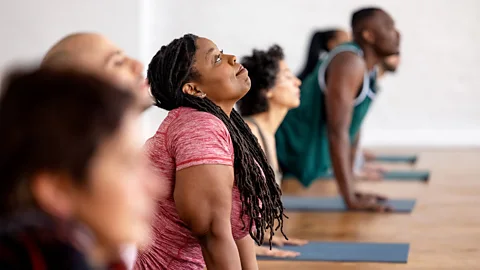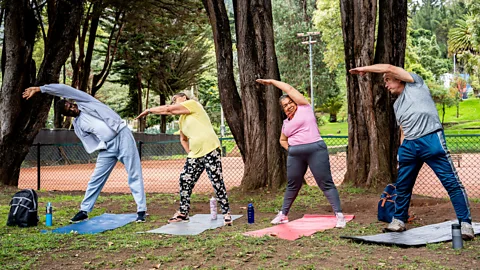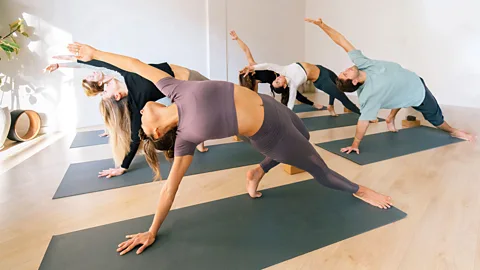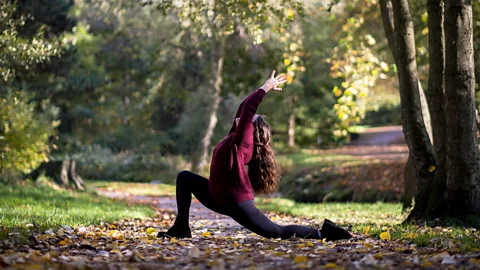
Why our fast-paced society loves yoga
This ancient practice is not only a fitness regimen, but science shows it’s also an antidote to modern stress.
Yoga on the Rocks draws sellout crowds of 2,100 practitioners to Red Rocks Amphitheatre outside Denver, Colorado. In the United States, yoga is an increasingly popular way to reduce stress and enhance health.
PUBLISHED DECEMBER 17, 2019 NATIONAL GEOGRAPHIC
More than 25 years ago, Derke discovered yoga. She was suffering from the searing abdominal pain of Crohn’s disease. Her doctor recommended surgery. Hoping to avoid it, she went to see a cousin who was a yoga master. He taught her the upside-down poses known as inversions. They are said to clear the body of toxins, though there’s no scientific evidence to support the claim. Derke’s symptoms quickly subsided. “Yoga saved my life.”
She trained as a yoga instructor, and if it’s not too hot, she holds free monthly classes on the courthouse lawn. When lawyers drone on at trial, she will order a break and lead jurors in standing stretches and breathing exercises. But she’s best known in legal circles as the judge who sentences offenders to take yoga behind bars.
Derke handles misdemeanors, such as shoplifting, minor drug possession, and driving under the influence, punishable by up to a year in jail. Offenders can cut their time by 40 percent or more if they take a weekly program called Yoga 4 Change. She sees yoga as a way to quiet self-defeating chatter in the mind and quell rage, fear, anguish, and compulsions that drive bad behavior.
“Once you let go,” she said, “you make room for the positive things.” Her colleagues, though, didn’t buy it at first. “Come on, yoga?”
Many offenders had a similar reaction. “I thought it was really weird,” said Cecil Reddick, an inmate at Jacksonville’s Montgomery Correctional Center.
An evaluation of the program in three Jacksonville facilities found that after six weeks, participants reported significant improvements in sleep, overall health, and the ability to manage anger and anxiety. At least two more county judges now offer the yoga option.
Some offenders choose to do their full sentence rather than try yoga, but Reddick grabbed the get-out-of-jail-quick offer from one of Derke’s colleagues. He was surprised by how much the classes relaxed him, soothed his sore back, and stirred a sensation he’d never felt: “Serenity.”
Yoga, a spiritual practice that began in India, has extended its limbs widely. In the United States, it’s held up as a fitness regimen, a path to transformation or enlightenment, and a treatment for so much that ails us—from addiction, headaches, and hearing loss to post-traumatic stress disorder, heart disease, and yes, Crohn’s.
More than 14 percent of U.S. adults used yoga for health reasons in 2017, up from 9.5 percent five years earlier, a government survey found. Since 2018, Harvard Medical School students have studied it as part of a required course on building resilience. Parents tote infants to Itsy Bitsy Yoga, which purports to improve a baby’s sleep, digestion, and brain development.
Validating health claims for yoga is difficult. Most studies involve too few participants to be conclusive, in large part because yoga does not generally attract big government grants or have an industry like drugmakers to finance research.
Sat Bir Singh Khalsa, a yoga instructor, Harvard neuroscientist, and expert on the science of yoga, acknowledges the research has a long way to go. “But I would say we have demonstrated our credibility.” Khalsa has investigated yoga for insomnia, PTSD, anxiety, and chronic stress, where he’s seen the most compelling evidence of yoga’s benefits.
Stress plays a major role in many illnesses that kill us. It also drives unhealthy eating, poor sleep, alcohol and drug misuse, and other bad habits. “Modern medicine really sucks at preventing chronic disease,” he said.
Khalsa, who took up kundalini yoga in 1971, told me with excitement that epigenetics and neuroimaging are revealing how the body and brain interact—and unraveling the mysteries of yoga’s power. In other words, the benefits aren’t just in a devotee’s mind.
Researchers in Norway analyzed blood from 10 volunteers before and after two-hour sessions of a yoga practice with rhythmic breathing and saw significantly increased gene activity in circulating immune cells. Scientists at UCLA studying breast cancer survivors discovered yoga decreased the expression of genes involved in inflammation, believed to be a root of many complex diseases.
Scientists at the National Institutes of Health found that longtime yoga practitioners don’t display the usual age-related declines in the brain’s gray matter. Yogis also had larger volume in several brain regions, including the hippocampus, critical to memory and emotional regulation, and the precuneus and posterior cingulate cortex, involved in attention and self-awareness.
Studies like these bring scientific legitimacy, but they’re not why the ancient discipline has caught on in a frazzled, fast-paced society. “Yoga is a strategy for making people basically happy and able to cope with modern life,” Khalsa said.
This may be the moment to admit that yoga stressed me out. I went on the recommendation of a physical therapist who had healed my injured shoulder after others had failed. When he spoke, I dutifully listened. In the 2.4-square-mile New York City suburb where I live, yoga is abundantly available in storefront studios, community recreation rooms, the continuing education program, and the chain health club. I started there, accompanied by my husband. Classes were packed. People jostled for space like subway commuters. Supple spandex-clad bodies bent, curled, and twisted in ways that defied me. It felt like one more competitive arena where I didn’t measure up. I took refuge in restorative yoga, where I seemed as adept as anyone at splaying across comfortable bolsters and trying not to snore. Meanwhile, my husband learned to stand on his head.
I’m not the only one to have a hard time reconciling the yoga scene with the potential of a serious practice. “I would get feedback that my playlist wasn’t cool enough,” said teacher Olivia Mead. “I thought, I cannot handle this anymore. I didn’t become a yoga instructor to wear cute shorts. I actually wanted to make a difference.”
Mead founded Yoga for First Responders. The nonprofit has brought yoga to police departments, fire stations, and training academies from Los Angeles to Thunder Bay, Ontario. Classes tailor the traditional yoga elements—physical postures, breath regulation, deep relaxation, and meditation—to help people endure the challenges of putting their lives on the line.
“The whole goal is to harness the mind,” she said, “not to touch your toes.”
Nineteen women wearing identical inmate T-shirts and pants took their spots on mismatched yoga mats arranged in a U-shape in a cramped room at Jacksonville’s Montgomery Correctional Center. Two uniformed officers stood watch over me; one of them, Sgt. Rhonda Warren, held an iPad and videoed my interviews.
It seemed an unlikely setting to release stress, not to mention harness the mind. Kathryn Thomas, a former Navy aviator who founded the nonprofit Yoga 4 Change, led the women through deep inhales and exhales, and then the fluid series of poses known as the sun salutation. Gradually, a sense of calm became palpable.
Most inmates weren’t required to come. Some signed up, as Melissa Bruce told me, “basically to have something to do.” Many wanted a break from the tension and clamor of living among inmates, an hour to sink into oneself. If they hadn’t all achieved enlightenment or transformation, at least a dozen told me they’d learned skills to help them survive another day. Philieza Lopano said she used the breathing exercises and gentle stretches during lockdowns to relieve anxiety.
Watching each woman stretch and fold and blow out her breath in loud, unembarrassed whooshes, it occurred to me that I might have fared better in yoga if I’d focused less on other people and more on myself, without judgment. After the women filed out of the room, I mentioned to Warren that I would try yoga again.
“I know,” she said, nodding slowly. “Me too.”
++++++++++++++++++++++++++++++++++++++++++++++++++++++++++++++++
The mind-altering power of yoga could improve your mental health
 Getty Images
Getty ImagesYoga has been found to increase grey matter and alter key networks in the brain. Now there are hopes it could be used to help improve people’s mental health.
My right arm is shaking. Sweat drips from my forehead as I twist my body from a side plank into a yoga pose known as “Wild Thing” – or “Camatkarasana”. It is quite the contortion – I arch my back, stretching my left arm over my head. My right foot is planted on the ground, and I look up to the sky.
One translation of the Sanskrit word camatkarasana is “the ecstatic unfolding of the enraptured heart” and is said to elicit confidence. And – despite the strain – I feel invincible.
When I started practicing yoga, I wanted to sweat and to build strength. I saw it purely as a form of exercise – but I found it was so much more.
The practice of yoga dates back over 2,000 years to ancient India. And though today, there are many different types of yoga – from meditative yin yoga to flowing vinyasa – through their use of movement, meditation and breathing exercises, all forms focus on a mind-body connection. And there is growing evidence that yoga may not just have physical benefits but may also be good for your mind too. Some researchers even hope it could be a promising way of helping people with post traumatic stress disorder (PTSD) cope with their symptoms.
And there is a growing body of research showing yoga can be beneficial for a wide range of health issues.
In epilepsy sufferers, for example, practicing yoga has been seen to significantly reduce the number of seizures – or even prevent them entirely. Yoga has been used as an intervention to help manage type 2 diabetes, reduce chronic pain, and aid in stroke rehabilitation. It has also been shown to be more effective than physiotherapy at improving the quality of life for people with multiple sclerosis, and one trial even suggests it could be beneficial for cancer survivors.
 Getty Images
Getty ImagesYoga can also help you live a healthy life for longer, says Claudia Metzler-Baddeley, a cognitive neuroscientist at the Cardiff University Brain Research Imaging Centre (Cubric) in the UK.
Metzler-Baddeley’s research focuses on the cognitive and neural mechanisms of ageing and neurodegeneration. “We think inflammation accelerates ageing – which can be caused by chronic stress,” she says. “Stress hormones like cortisol cause inflammation, which can cause increased blood pressure. These are, of course, risk factors for unhealthy ageing.”
Meditation and mindfulness, she adds, are integral to yoga practice, and “seem to induce changes in brain networks which are important for metacognition, meta-awareness, and regulating emotional responses to stress”.
“We know there’s potential [for yoga to] keep us healthy as we age,” she says. “There are studies that have found a number of structural differences [in the brains of people who practice yoga], and that certain areas important for metacognition and problem solving seem to be larger.”
Neuroimaging has revealed yoga can lead to an increase in the volume of grey matter in the brain. Grey matter – or the cerebral cortex – is important for mental processes including language, memory, learning and decision-making. In Alzheimer’s disease, there is a loss of grey matter volume and one 2023 study found yoga could slow memory loss among women at risk of the disease.
All exercise is known to boost your mood by lowering levels of stress hormones and increasing the production of endorphins – often referred to as the “feel-good chemicals”. But the combined postures, breathing and meditative exercises in yoga may have additional benefits, reducing anxiety, stress, depression and improving overall mental health. Studies have shown that yoga can improve the short-term symptoms of depression, for example.
“I didn’t want to go on. Life was too difficult,” says Heather Mason, founder of yoga therapy training school The Minded Institute. “Yoga transformed my life – helping me manage depression, anxiety and PTSD.”

After experiencing the profound effects of yoga, Mason went on to train in yoga, psychotherapy and neuroscience, before founding her yoga therapy training school in 2009. “I felt there were a lot of claims [about yoga] that were made that had no substantiated evidence. And when you have been hopeless for most of your life, you don’t want to be peddled something that might work,” she says.
It can be expensive, too, she adds, “This is why I am so dead set on its integration into the NHS [the UK’s National Health System].” Plus, people with mental health issues can often struggle to engage in self-care, she explains. “They have to be motivated to do it. I thought, if we can bring it into the medical paradigm – all that will change.”
Yoga has been found to increase levels of gamma-aminobutyric acid (Gaba) in the brain. This neurotransmitter slows down brain activity by blocking a nerve cells ability to receive and send chemical messages. Studies have found a 12 week course of yoga leads to increases in Gaba that were correlated to improvements in mood and decreases in anxiety.
“With meditation and deepening the breath, you switch from sympathetic to parasympathetic nervous activity. So, you’re triggering the relaxation response,” says Metzler-Baddeley.
Researchers have found that people who practice mind-body interventions such as yoga and meditation experience a decrease in the production of cytokines – and so a reduction in the risk of inflammation-related diseases and conditions.
There are also some indications that yoga could be beneficial for some people suffering from PTSD. However, the results from other studies using yoga as an intervention for PTSD are mixed and there appears to be a shortage of high-quality research, according to one academic review. One recent study, however, showed that yoga could improve the outcomes of US veterans with PTSD while another showed frequent yoga practice could be beneficial for women with chronic PTSD.
“Treatment-resistant PTSD is a big problem,” says Rachel Bilski, a yoga therapist and manager of the non-profit PTSD UK. “At the age of about 11, I was given a fistful of Prozac and cognitive behavioural therapy. Nothing worked. By my mid-teens, I was suicidal. I felt more broken because treatment wasn’t working. It was like, if this is supposed to work and it isn’t working, then there’s something inherently wrong with me, and there’s no way I’ll ever be fixed.”

On a “classic” post-university trip to Southeast Asia, she thought to herself: “Okay, let’s try this yoga thing. It’s probably for hippies.” Every day, during savasana – at the end of the class when participants lie on the floor in relaxation – “I would cry and cry and cry,” says Bilski. “I was crying from places that I didn’t even understand. I was feeling different things. I was feeling safety in my body in a way that I didn’t realise I needed. It was such a huge shift in one week.”
Bilski cancelled all her plans for partying and instead, “went from yoga retreat to yoga retreat, and then ended up training, and then ended up going into yoga therapy”.
Yoga therapy, she says, is distinct from other forms of yoga – not all types of yoga are good for PTSD sufferers, One recent review found evidence that types of yoga such as kundalini, satyananda, and hot yoga – which is practiced in a heated environment – could be most useful as an intervention.
In addition, most yoga teachers, says Bilski, are not equipped to deal with trauma. “You need a trauma-informed teacher. There are a lot of yoga teachers out there that could potentially provide classes that end up triggering people.” If your body doesn’t feel like a safe place to be, for example, but a yoga class brings a high level of awareness to your body, “then you can end up becoming triggered”.
Yoga therapy, explains Bilski, is usually done on a one-to-one basis, tailored to the participant’s specific needs, and focuses on “grounding skills” and breathing practices. “[By] tracking sensations in the body, we can decouple safety cues from danger cues. We use a posture as a vehicle for that kind of exploration, and self-regulation through breathing,” says Bilski.
Yoga therapy, she says, can help PTSD sufferers to tolerate the physical or sensory experiences associated with their trauma. Giving people the means to control their symptoms in this way, say experts, indicates yoga has an “important role to play in the field of trauma recovery”. Yoga is often used in tandem with other types of treatment. Just one of a list of complementary interventions – such as acupuncture, guided imagery and hypnotherapy – yoga can offer a second-line treatment option.
Metzler-Baddeley notes, however, that much of the research focuses on the mindfulness and breathing aspects of yoga – and not on holding poses, stretching or movement.
It is an area that will require more research to unravel fully. But in the meantime, with both feet planted firmly on the ground, my line of sight on my middle finger, my arms outstretched in Virabhadrasana 2 pose – or Warrior 2 – I feel calm and strong, and present in the moment.
“Yoga can shift the whole mind-body complex.” says Mason. “It’s a long road but it has that power. I think that’s probably why it’s been practiced for thousands of years.”
